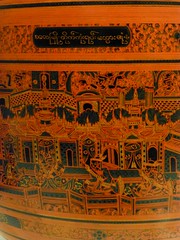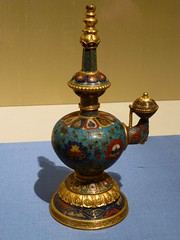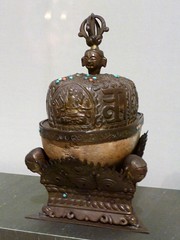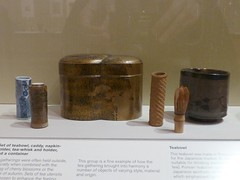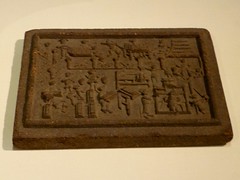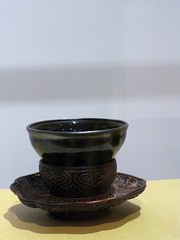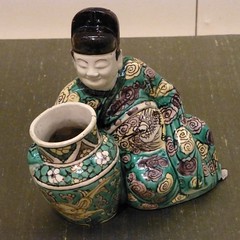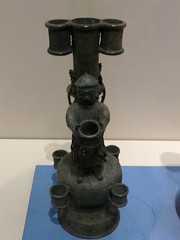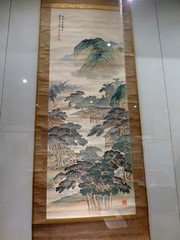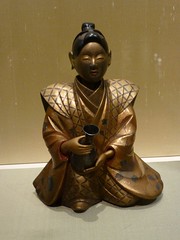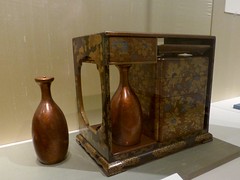Ancient Greece: The Greatest Show on Earth
The last part of Michael Scott’s series about Greek drama looked at what happened after Greece was conquered by Rome. It felt a little less focussed than the previous two episodes, possibly because the Romans aren’t as much his thing as the Greeks? The theme was that Rome both preserved this art form (and Greek plays, too) and also changed it along the way. Early Roman culture frequently mimicked Greek culture. Scott positioned this as them seeing the Greeks as “this is how a civilised culture acts” and so imitating it to make sure everyone knew they were civilised too. Then later there’s more of an element of “we can do it bigger & better” – the temples & monuments still have that classical style but they’re much more over the top. So drama got a foothold in Roman culture as it conquered the Greek city states in Italy, and gradually became a common sort of entertainment. In Greece drama had been closely connected to the political process & the people who produced it (playwrights, actors etc) had high status. In Rome drama was only entertainment, and while playwrights might still command respect actors were much lower status. And woe betide the playwright who took too obvious a dig at the powers that be, much better to stick to safe subjects.
An interesting series about something I didn’t know that much about 🙂
John Sergeant on Tracks of Empire
In the second & final part of John Sergeant’s trip on the Indian railway he travelled from north to south. Along the way he talked about the construction of the railways. I hadn’t realised everything was shipped across to India from Britain, because there wasn’t the industrial capability in India to build it. This includes not just the tracks and so on, but the actual trains themselves. He also visited a Maharajah’s palace – once upon a time the train ran direct to the door, as part of the British Empire keeping the Indian Princes onside.
The railways revolutionised Indian transport – prior to the British building them transport for most people was by foot or by animal. The increased mobility both connects people to the wider country, and allows for a lot more trade. Obviously the British benefited from that first, but modern Indian businessmen still use the same railways for their goods transport. The railways also generated a lot of jobs (and many of those jobs went to people who would otherwise have been shunned – Anglo-Indians for instance who weren’t welcomed in either English or Indian societies). And this is still true today. Sergeant visited a laundry facility (where it seemed it was all done by hand) and a leather workshop (again, handmade bags for all the railway employees/business).
So the railways have brought much good to India, but it was at a high price. Sergeant visited Bhore Ghat just south of Mumbai where the engineering difficulties of building a railway through a mountain range in a hot country with Victorian technology lead to a lot of deaths. Europeans tended to die of fevers, the engineer who was supposed to be running the project died not long after he arrived in India but his wife took over the project management and it was still completed on time & under budget. The Indians tended to die from industrial accidents and many more of them died.
Nigel Slater: Life is Sweets
This programme was a combination of a history & survey of British sweets, and personal reminiscences by Nigel Slater. I think I would’ve preferred more history/survey & less autobiography – particularly as I only have the vaguest idea who Nigel Slater is. But it did fit the primary theme of the programme, that sweets can be very good memory triggers. And as the programme went on I definitely had my own trips down memory lane – sweets I remembered, adverts I remembered, memories associated with particular sweets (in particular I hadn’t thought about peppermint creams at xmas for years, I don’t remember when Dad last made them either. Marzipan fruits too!). The bits & pieces of history were also interesting – I don’t think I ever knew that cocoa (the drink) was being pushed by the Quakers as an alternative to alcohol in a part of the Temperance Movement in the Victorian era. Which “explains” the Quaker origins of the chocolate companies. I also didn’t know that UFOs and aniseed balls both derive from medicine packaging of a bygone era.
Fun, but I’m not sure how much appeal it would have if you aren’t of the right age & country to remember the sweets.
The Ottomans: Europe’s Muslim Emperors
This is a recent series covering the history of the Ottoman empire, with an emphasis on how this history affects the current politics & unrest in the Middle East today. In the first episode Rageh Omaar covers the beginnings of the Ottoman Empire, the first two hundred years or so. A lot new here for me, I don’t really know much about the history of the Ottomans. They start as a nomadic tribe of horseback warriors, who fight as mercenaries as part of how they survive. From settling down in 1300-ish near the Turkish town of Sogut they start to conquer the lands around them, and construct a settled Ottoman state. At first this included a lot of the land around Constantinople but not the city itself, but in 1453 Mehmed II’s army succeeded (with the help of their superior military tech – cannons) to capture the city and turn it into Istanbul (here, have a free They Might Be Giants earworm. You’re welcome)*. This was a hugely symbolic moment – it was seen as the victory of Islam over Christianity. This was also the point where the Ottoman state began to turn into the Ottoman Empire. So far the Ottomans had been fighting Christians, and fighting other Muslim states was not the done thing – this changed when tensions increased between the Ottomans & the Safavid Empire. As the Safavids were Shiite and the Ottomans were Sunni the “obvious” solution was to declare the Shiites heretics, and then they were fine to go to war with – which is still having repercussions today.
*Omaar gave the impression the Ottomans changed the name of the city, but while I was looking for that vid I ran across a few mentions that it might’ve been the Turks after the breakup of the Ottoman Empire. I don’t know which is right, but I still got that earworm during the programme 🙂
Omaar also talked a bit about life in the Empire in this period – the Sultan with his harem of concubines, fratricide between rival sons of the Sultan, Christians as tolerated but second class citizens. In his eagerness to emphasise that life in the Ottoman Empire wasn’t as bad as later history might suggest (i.e. the folk history of the peoples in Greece & Bulgaria etc who were conquered by the Ottomans) I think Omaar went a bit too far towards apologising for them. In particular the “it wasn’t that bad” of children being taken from (Christian) conquered families as slaves – army for the boys, concubines for the girls) – was a bit tenuous: they wouldn’t take your last son! it was quite a good life! Or the comparison of the fratricide to the succession wars in Europe in the same time period (Wars of the Roses, Hundred Years War) – doing your killing by policy rather than sometimes having wars isn’t quite a good v. bad distinction to me 😉 How about two shades of grey?
Stories from the Dark Earth: Meet the Ancestors Revisited
The second episode of Stories from the Dark Earth was desperately padded, with not much new stuff – if I’d seen the older series I think I’d’ve been rather disappointed. The two excavations were both of neolithic burials – one in Dorset & one in Orkney. The Dorset one is near a great earthwork called the Dorset Caucus – function unknown, and probably unknowable. One reason this burial is notable (apart from just because neolithic burials are only rarely found) is that in the original work they used isotope analysis of the teeth of the four skeletons to show that two had grown up in one area and two in the area where they were buried – the woman and the youngest child weren’t local, the two older children were. This was apparently the first proof of concept for using this sort of analysis on teeth, and all the problems that the PhD student (at the time) had had getting people to let her do analysis on their skeletons suddenly vanished once she’d been on telly. I suspect the way it was presented in the programme is likely to’ve been simplified to make a nice story 😉 One new thing for that burial was that in the last 15 years someone has done analysis of snail shell fragments in soil samples across the area, these have changed the perception of the landscape the people lived in – not dense forest across the whole region, but changing from wooded to cleared at the Dorset Caucus. The other new thing is that by correlating radiocarbon dates with archaeological evidence they’ve figured out there’s a 45% chance that the woman was alive when the earthwork was being constructed. A datapoint I was a trifle underwhelmed with (as I was also underwhelmed with the DNA evidence shown earlier about relationships between the woman & children) – the narrative of the show presented this as far more conclusive than it actually sounded like.
The Orkney burial had been in a pretty poor condition when discovered – fragile rotted bones & lots of missing bits. Originally assumed to’ve been as a result of a burial rite that involved letting the bones be picked clean by animals before interring them. But they’re now pretty sure this can’t’ve been the case – the missing bits include the bigger bones, not just the small ones. Some other bones from the area (and time period?) have had holes drilled in them after they’d been interred for a while, so clearly this culture had a different attitude to dead people than we do. No “rest in peace” here. And that was pretty much it for this half, only it was dragged out to about half an hour somehow. Oh, there was also something about a new tomb discovery only the excavations there aren’t very advanced yet.
A Hundred Years of Us
The second episode of this series was a mix of the fascinating and the banal. Banal included Phil Tufnell being a cheery chappy and finding out that Working On A Farm Is Hard (with c.1911 techniques) – not exactly news. But the segment on tuberculosis, and the start of the NHS, was fascinating – they had interviews with a woman who’d been a nurse in a sanatorium in 1948 and with a surviving patient from that sanatorium. The patient had been about 15 years old in 1948 and was one of the first people to be given streptomycin after the NHS started – if it had been left much longer she’d’ve died, and 12 weeks after treatment she was well enough to leave the sanatorium and go back home. If the NHS hadn’t been formed there’s no way she or her family could’ve afforded treatment, that’s why she was in the sanatorium waiting to die in the first place.
Other topics for the episode ranged from holidays (and the rise & fall of the Butlins style holiday camp), hats, to the end of rationing after WWII. There was some peculiar editing of the sat-on-the-sofa-chatting segments that meant people got obviously cut off and it didn’t look very smooth.


